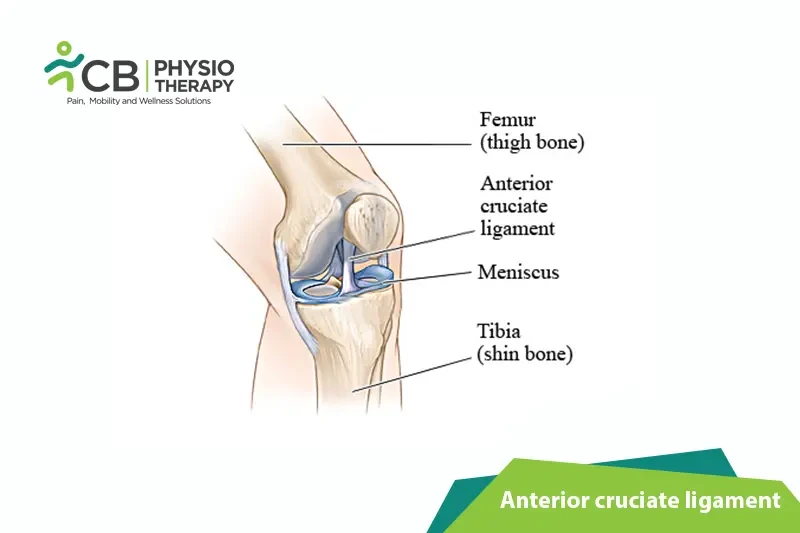
The anterior cruciate ligament (ACL) is one of the two cruciate ligaments which help in the stabilization of the knee joint. It is a strong band made of connective tissue and collagenous fibers that originate from the anteromedial part of the intercondylar region of the tibial plateau and extends posteromedially to get attached to the lateral femoral condyle. During flexion and extension, both the anterior cruciate ligament (ACL) and posterior cruciate ligament (PCL) prevent excessive forward or backward motion of the tibia in relation to the femur.
Signs and symptoms of anterior cruciate ligament tear vary from patient to patient depending on the intensity of the tear. A few of the common symptoms are mentioned below:
Pathology:
ACL tears occur in the middle portion of the ligament and appear as discontinuity of the ligament or abnormal contour. The injury also leads to alteration in the mechanics of the knee. This mechanical deficit can lead to an increase in meniscal injury.
An ACL tear is usually sudden and can be seen in both contact and non-contact sports. It can also occur:
Physical examination:
During the physical examination, the examiners check the knee for swelling and tenderness and compare the injured knee to the uninjured knee. The knee is also moved into a variety of positions to assess the range of motion and overall function of the joint.
Lachman test:
The patient is asked to lie in a supine position on the bed. The patient's knee is placed in about 20-30 degrees flexion. The leg should be in slight external rotation. The examiner places one hand behind the tibia and the other on the patient's thigh but the thumb should be on the tibial tuberosity while pulling the tibia anteriorly, usually ACL should prevent forward translational movement of the tibia on the femur. But if the test is positive then the anterior translation of the tibia is associated with a soft or a mushy end feel.
Anterior drawer test:
The patient is asked to lie supine on a plinth with hips flexed to 45 degrees, knees flexed to 90 degrees, and feet flat on the plinth. The examiner sits on the toes of the tested extremity to stabilize it. The examiner grasps the proximal lower leg, just below the tibial plateau or tibiofemoral joint line, and tries to translate the lower leg anteriorly. The test is positive if there is a lack of end feel or excessive anterior translation as compared to the contralateral side.
X-rays:
X-rays are done to rule out a bone fracture. Though it doesn't show soft tissues, such as ligaments and tendons.
Magnetic resonance imaging (MRI):
Magnetic resonance imaging (MRI) uses radio waves and a strong magnetic field and creates images of both hard and soft tissues in the body. Magnetic resonance imaging shows the extent of an injury and signs of damage to other tissues in the knee, including the cartilage.
Ultrasound:
Ultrasound uses sound waves to visualize internal structures. It is also used to check for injuries in the ligaments, tendons, and muscles of the knee.
Medications: Anti-inflammatory drugs, a steroid medication, etc.
Note: Medication should not be taken without the doctor's prescription.
Surgery:
Surgery is required if the ACL is torn badly, if the knee gives way while walking, or if the person is an athlete. During the surgery, the damaged ACL is removed and replaced with tissue to help a new ligament grow in its place.
Rest :
Rest and staying off the feet for a while is recommended to enhance the process of healing by decreasing the movement of the knee joint.
Knee brace:
A knee brace provides extra support for the patients having damaged ACL while running or playing sports.
Compression:
Bandaging can be done to decrease the swelling in or around the knee joint by wrapping an ace bandage around the knee.
Elevation:
Elevation of the affected limb also decreases swelling and edema. The patient is made to lie down with the knee propped up on pillows.
Ice packs may be used to decrease swelling. Ice is applied on the knee at least every two hours for 20 minutes at a time.
Transcutaneous electrical stimulations (TENS):
Transcutaneous electrical stimulations (TENS) help to decrease knee pain and knee swelling.
NMES:
NMES is given to improve the strength of quadriceps muscles and to regain normal quadriceps control.
This therapy uses red and infrared light for the relief of pain, accelerates the process of healing, and decreases inflammation. The light source is placed against the skin, then the photons penetrate several centimeters and get absorbed by the mitochondria, which is the energy-producing part of the cell.
Shockwave therapy is highly effective in ACL tear, it enhances the process of healing and results in early recovery.
.
Gait training:
Gait training is given with help of assistive devices like crutches, and progressed from walking with crutches to walking normally with no assistive device. Crutches can help to keep weight off the knee.
Pain and swelling in the knee can limit the knee's range of motion. Simple range of motion exercises can be done to help improve and normalize knee mobility like prone hang.
Strengthening exercises:
Strengthening exercises are used to strengthen the quadriceps, hamstrings, and hip muscles e.g like isometric, isotonic, and isokinetic exercises can be done to strengthen the muscles.
Balance exercises:
After an ACL tear, the patient has difficulty maintaining appropriate balance on the injured leg. For balance training wobble board or a BAPS board may be used to regain normal proprioception, or body awareness, after the injury.
Plyometrics:
Plyometrics helps to return to high-level sports. Plyometric training helps to learn to properly jump and land and regain the confidence needed to return to athletics.
The patient is educated to learn how to prevent re-injury of the ACL. The patient is advised to continue the physiotherapy strengthening exercises even after recovery to gain maximum strength.
Select your City to find & connect with our experts regarding Physiotherapy for Anterior Cruciate Ligament Tear(acl)